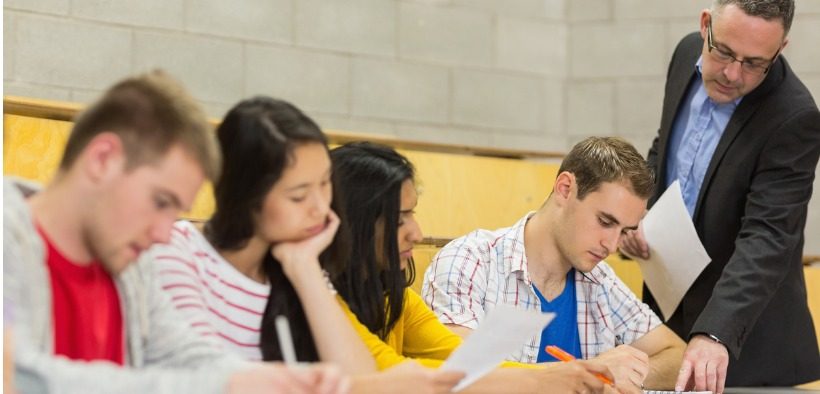Do you see the same problems in student assignments time after time? Do you find that your students don’t act on the feedback that you have spent so much time providing?
This article introduces the concept of student feedback literacy and suggests practical ways in which students can become actively involved in using feedback to enhance their learning. As Dylan Wiliam (2016) puts it, “the only thing that matters is what the student does with the feedback” (p. 15).
Feedback is quite a slippery term to define. Is it mainly comments from teachers to students or should more parties be involved? How does it relate to grading student work? If a teacher produces insightful comments but the student does nothing with them, can we still call it feedback or is it just an unclosed loop?
An active student role in feedback needs to be reflected in its definition: feedback is a process through which learners make sense of comments from teachers or peers and use them to enhance their work or learning strategies (Carless, 2015). Implicit in this definition are both the central role of students and the need for action in response to comments.
Developing feedback literacy
Students find it difficult to understand and use feedback because they lack feedback literacy i.e. the academic skills to work effectively with comments. Student feedback literacy denotes the understandings, capacities, and dispositions needed to make sense of comments and use them for enhancement purposes (Carless & Boud, 2018).
Four inter-related features identified as essential to students’ feedback literacy are:
- Appreciating feedback—Students need to be motivated to appreciate feedback processes and see their value.
- Making judgments—Students need sustained practice in making sound academic judgments about their own work and that of others.
- Managing emotions—Students need to minimize defensive emotional reactions to critical feedback and see it as a tool for improvement.
- Taking action—Students need to act on feedback to improve their work, or even better their learning strategies (Carless & Boud, 2018).
Valerie Shute (2008) likens feedback to a “good murder” needing motive, opportunity, and means. Students often lack opportunities and strategies to act on feedback. For example, when major assignments are due at the end of courses, there is little opportunity for students to make use of any feedback they might receive. End-of-semester teacher marking is a part-and-parcel of academic life, but it is more of a grading and accountability exercise than one that promotes improvement.
One of the most useful things teachers can do to encourage students to use the feedback provided is to design curriculum and assessment in ways that facilitate it. This can be done in various ways. One method is teacher feedback on a mid-semester assignment followed by a second parallel end-of-semester assignment, with students incorporating feedback from the first to improve the second. This kind of formative assessment helps students identify learning gaps and understand what they need to do to improve.
Incorporating peer feedback
Another fundamental strategy for developing feedback literacy is peer feedback, which puts more responsibility in students’ hands. A standard peer feedback sequence is that learners produce a draft assignment, receive feedback from peers, and then revise the same assignment. Such processes have various advantages: there are opportunities for dialogue; the process involves learning to make judgments; and there is potential for student action on comments received.
But peer feedback is often implemented ineffectively. Unless teachers provide sufficient training and support, students may not understand how to do it properly or fully appreciate its benefits. Training clarifies purposes and guidelines for peer feedback, and it helps students gain experience in generating or using rubrics. Training also provides opportunities to address students’ concerns about peer feedback.
Students also need coaching on how they can carry out peer feedback more effectively. Teachers can discuss with students useful and not so useful examples of peer feedback. For example, comments focused on the bigger picture of writer intentions, argumentation, and organization are more insightful than surface comments on spelling or grammar.
Feedback is a social practice influenced by relationships between participants. Teachers need to create course climates where peer feedback can flourish. Feedback thrives when participants share a sense of mutual improvement in a supportive, open, and trusting atmosphere.
Probably the biggest challenge in feedback is promoting student action. Curriculum design and related learning activities should enable a core feature of student feedback literacy: the need for uptake. In subsequent work, students should be prompted to show how they have used previous comments. On their assignment cover sheet, for example, students could be required to summarize which aspects of previous feedback they are addressing in the current assignment.
To sum up, although it is ultimately up to students to make better use of the feedback they’re provided, teachers need to design curriculum and assessment in ways that involve students in feedback processes. Most importantly, students need plentiful opportunities to use feedback to improve performance.
References
Carless, D. (2015). Excellence in University Assessment: Learning from award-winning practice. London: Routledge.
Carless, D. & Boud, D. (2018). The development of student feedback literacy: Enabling uptake of feedback. Assessment and Evaluation in Higher Education, https://doi.org/10.1080/02602938.2018.1463354.
Shute, V. (2008). Focus on formative feedback. Review of Educational Research, 78 (1), 153-189.
Wiliam, D. (2016). The secret of effective feedback. Educational Leadership, 73(7), 10-15.
David Carless is a tenured professor in the faculty of education, University of Hong Kong. He specializes in research focused on feedback for student learning in higher education. He has pioneered the concept of sustainable feedback. His most well-known publication is the book, Excellence in University Assessment published by Routledge in 2015. He tweets about feedback research @CarlessDavid.






